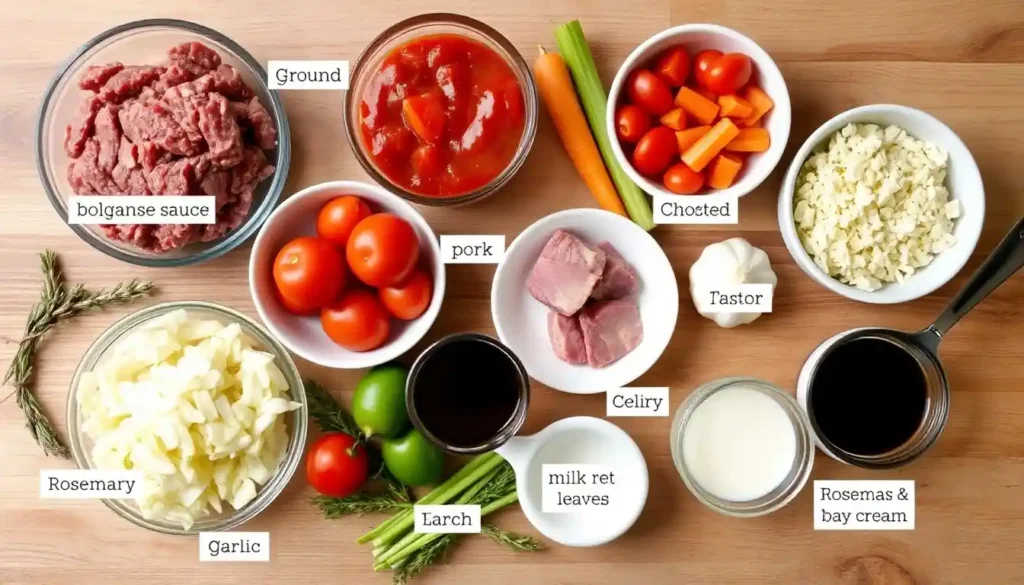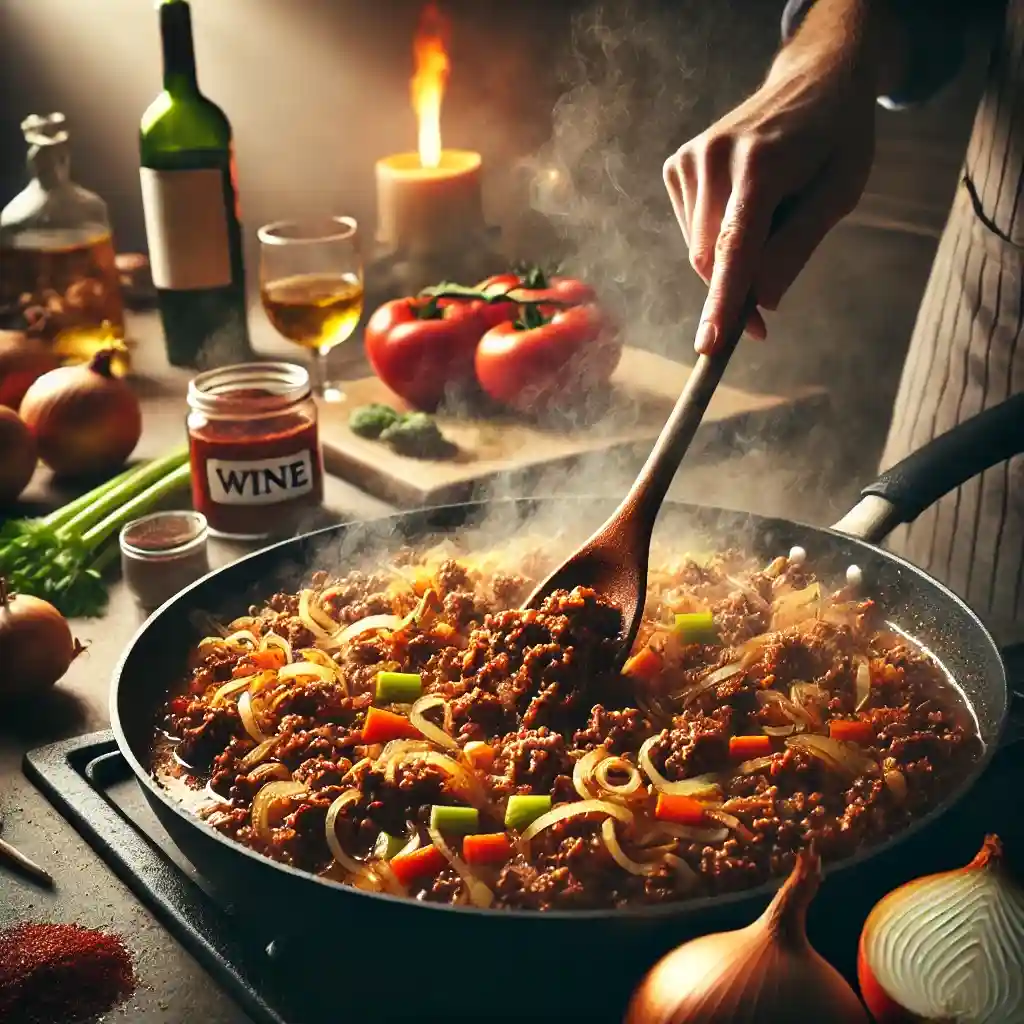Introduction to Spaghetti Bolognese
What is Spaghetti Bolognese?
Spaghetti Bolognese, often just called “Bolognese” or “spag bol,” is a beloved pasta dish made with a rich, meaty tomato sauce served over spaghetti. Though its origins are rooted in Italian cuisine, specifically in Bologna, the dish has evolved significantly outside of Italy, where the traditional recipe (ragù alla Bolognese) is served over broader pasta like tagliatelle rather than spaghetti. This guide combines elements of authentic Italian Bolognese with modern adaptations to create a hearty, flavorful dish that’s easy to make and perfect for sharing.
Historical Background
Originating from Bologna, Italy, Bolognese sauce is typically slow-cooked and rich in flavor, relying on a blend of ground meats, vegetables, and tomatoes. Unlike many tomato-based sauces, it often incorporates milk or cream, giving it a smooth texture and a slightly sweet taste. Traditionally, it’s served with tagliatelle rather than spaghetti, but the latter has become popular worldwide as a pairing for this dish. Here, we’ll explore a version that respects the original flavors while being adapted for today’s kitchen.
Key Ingredients for Spaghetti Bolognese
Primary Ingredients
The ingredients in a classic Bolognese sauce come together to create layers of savory, aromatic flavor. Here’s what you’ll need:
- Ground Meat: A blend of beef and pork creates a rich, balanced flavor. Pork adds fat and tenderness, while beef brings a hearty taste.
- Aromatic Vegetables: Onions, carrots, and celery form the base (known as soffritto in Italian cooking) and add depth.
- Tomato Base: Tomato paste, puree, or crushed tomatoes provide the sauce’s body and acidity.
- Herbs and Seasonings: Bay leaves, thyme, rosemary, and salt are traditional. Fresh herbs are ideal, but dried versions work too.
- Wine and Dairy: Red or white wine enhances flavor complexity, while milk or cream helps balance acidity and adds smoothness.
Table of Contents
Ingredient Variations:
- No-Wine Option: Substitute wine with a splash of beef broth or add a pinch of sugar if tomatoes are very acidic.
- Lower-Fat Choices: Use lean meats and skip the cream, opting for a tomato-heavy sauce if preferred.
- Vegetarian Twist: Substitute meats with lentils or mushrooms for a hearty, meat-free version.

Why These Ingredients Work Together
Each component of Bolognese has a purpose in enhancing the dish’s taste. Meats provide richness, vegetables add sweetness, and tomatoes lend acidity. The addition of wine deepens the flavors, and milk or cream balances the overall taste, making the sauce smooth and savory.
Cooking Techniques for Authentic Bolognese
Building Flavors from the Start
In any great Bolognese sauce, layering flavors is key. Here’s how to bring out the best in each ingredient:
- Sautéing Aromatics: Begin with the soffritto of onions, carrots, and celery in olive oil over medium heat until they’re soft and fragrant. The slow cooking releases their sweetness, enhancing the sauce’s base flavor.
- Browning the Meat: Once the vegetables are softened, add the ground meats. Cooking the meat at a higher heat, breaking it into smaller pieces as it browns, ensures it gains a deep, caramelized flavor without steaming.
- Adding Wine and Reducing: After browning, deglaze the pan with wine, scraping up browned bits from the bottom. Simmering until the wine reduces prevents any harsh alcohol flavor and concentrates the sauce’s richness.
Simmering for Depth of Flavor
One of the hallmarks of traditional Bolognese is its long cooking time. Authentic recipes call for simmering for at least two hours (some for up to four hours!), which allows the flavors to meld and the sauce to thicken gradually. The sauce should bubble gently on low heat, ensuring the meat stays tender and the flavors are well-integrated.
Pro Tip: If time is limited, a 30-minute simmer is enough to create a flavorful sauce, though longer cooking enhances the depth. For a true flavor boost, slow-cook for 2-3 hours on the stovetop, or try a slow cooker for set-it-and-forget-it convenience.
Optional Cooking Variations
If stovetop cooking isn’t practical, alternative methods work well too:
- Slow Cooker: After browning ingredients, transfer everything to a slow cooker. Cook on low for 3-4 hours.
- Instant Pot: This can reduce cooking time significantly. After sautéing, pressure cook the sauce for 20 minutes, then let it release naturally
Step-by-Step Recipe for Spaghetti Bolognese
Preparation Steps

- Prepare the Vegetables: Dice the onions, carrots, and celery into small pieces. This allows them to mix seamlessly into the sauce.
- Sauté the Aromatics: Heat a couple of tablespoons of olive oil in a large, heavy-bottomed pan over medium heat. Add the diced onions, carrots, and celery. Sauté for about 5-7 minutes, or until they’re softened and slightly golden.
- Brown the Meat: Increase the heat slightly and add the ground beef and pork. Cook the meat, using a spoon to break it apart, until it’s browned and there’s no pink left—this should take about 5-10 minutes.. For best results, avoid crowding the pan, as this can prevent browning.
- Deglaze with Wine: Pour in ½ cup of red or white wine, letting it sizzle as you scrape the pan’s bottom to release browned bits. Let it simmer until most of the wine has evaporated, around 2 minutes.
- Add Tomato Paste and Base Ingredients: Stir in a tablespoon of tomato paste, then add the crushed tomatoes or passata, bay leaves, and herbs (like rosemary or thyme). Season with salt and pepper.
- Simmer the Sauce: Lower the heat, partially cover the pot, and let the sauce gently simmer for 1-2 hours, stirring now and then. If the sauce thickens too much, add a little water or beef broth as needed.
- Add Milk or Cream (Optional): For a richer texture, add a splash of milk or cream during the last 30 minutes of cooking.
- Taste and Adjust Seasoning: Once cooked, taste and adjust salt, pepper, or herbs as needed. Remove bay leaves and discard.
Cooking the Spaghetti
- Boil the Pasta: Bring a large pot of salted water to a rolling boil, then add spaghetti. Cook according to package instructions, aiming for al dente (usually about 1 minute less than suggested time).
- Combine Sauce and Pasta: Once drained, toss the spaghetti in the pan with a generous amount of sauce, allowing the noodles to soak up the flavors.
- Serve: Garnish with grated Parmesan and a sprinkle of fresh parsley or basil if desired.
Note: Always save a cup of pasta cooking water. Adding a splash when mixing the sauce with the spaghetti helps the sauce stick to the pasta more effectively.

Tips for the Perfect Bolognese
Flavor Tips
- Balancing Acidity: If the sauce tastes too acidic, add a pinch of sugar or a splash of milk to smooth out the flavor.
- Season Gradually: Adding salt gradually helps control the flavor and prevent over-seasoning.
Consistency Tips
- Thickening the Sauce: For a thicker sauce, let it simmer uncovered for the last 30 minutes. Conversely, if it’s too thick, a bit of beef broth or pasta water can help loosen it up.
- Proper Pasta Texture: Cooking the pasta to al dente and tossing it directly in the sauce creates a cohesive, flavorful dish.
Serving Suggestions
- Garnish for Extra Flavor: Freshly grated Parmesan, a drizzle of olive oil, or a sprinkle of fresh herbs elevate the final presentation.
- Perfect Sides: Garlic bread, a green salad, or steamed veggies add balance to the meal.
Variations of Spaghetti Bolognese
- Authentic Italian Ragù Bolognese
- For a more traditional Italian take, try using white wine instead of red and serving with tagliatelle instead of spaghetti. Authentic ragù often incorporates pancetta or pork for added richness and uses milk to soften the sauce’s acidity.
- Vegetarian Bolognese
- Swap meat for lentils, mushrooms, or plant-based ground meat alternatives. Mushrooms provide a hearty texture and earthy flavor that mimic traditional Bolognese.
- Quick Weeknight Bolognese
- For a faster version, reduce simmering time to 30-45 minutes, and use pre-cooked ground meat if necessary. The sauce will be less complex but still delicious.
- Low-Calorie or Lean Bolognese
- Use lean ground turkey or chicken and skip the milk or cream for a lighter meal. Extra vegetables like zucchini or bell peppers can add volume and nutrients.
Frequently Asked Questions
Can I Freeze Bolognese Sauce?
Yes, Bolognese sauce freezes exceptionally well. Allow the sauce to cool, then portion into freezer-safe containers or bags. It can stay good in the freezer for up to three months.. To reheat, thaw overnight in the fridge, then warm gently on the stove.
What Can I Use Instead of Wine?
If you’d rather skip the wine, you can use beef broth or a little balsamic vinegar to add depth. To bring in a bit of sweetness, just add a pinch of sugar..
How long will Bolognese sauce stay good in the fridge?
Stored in an airtight container, Bolognese sauce keeps for 3-4 days in the refrigerator. Reheat it thoroughly before serving.
What’s the Best Pasta for Bolognese?
While spaghetti is popular, traditionalists recommend tagliatelle for its ability to hold thick sauces. Other options like rigatoni and fettuccine also work well with hearty Bolognese.
Conclusion
Making Spaghetti Bolognese from scratch is a rewarding experience that brings the comfort of Italian cuisine into your kitchen. With a few staple ingredients and the tips shared here, you’ll create a deliciously rich and hearty meal. Try different variations, find your favorite tweaks, and enjoy every comforting bite!

